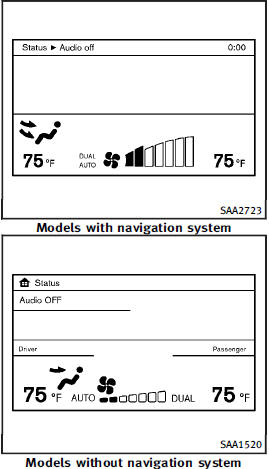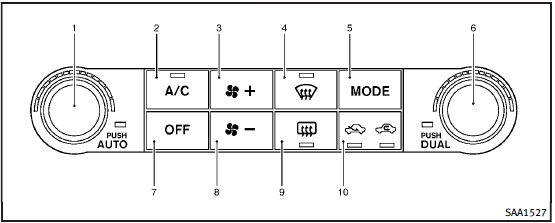Automatic climate control

WARNING
• The air conditioner cooling function operates only when the engine is running.
• Do not leave children or adults who would normally require the support of others alone in your vehicle. Pets should not be left alone either. On hot, sunny days, temperatures in a closed vehicle could quickly become high enough to cause severe or possibly fatal injuries to people or animals.
• Do not use the recirculation mode for long periods as it may cause the interior air to become stale and the windows to fog up.
Start the engine and operate the automatic climate control system.
When the “STATUS” button is pushed, the automatic climate control status screen will appear. (See “How to use STATUS button”.)

Automatic climate control
You can individually set the driver and front passenger side temperature using each temperature control button (if so equipped).

Type A
1. “AUTO” automatic climate control ON button/Temperature control dial (driver side)
2. “A/C” air conditioner ON/OFF button
3. “ ” fan speed increase button
” fan speed increase button
4. “ ” front defroster button
” front defroster button
5. “MODE” manual air flow control button
6. “DUAL” zone control ON/OFF button/Temperature control dial (passenger side)
7. “OFF” button for climate control system
8. “ ” fan speed decrease button
” fan speed decrease button
9. “ ” rear window defroster button
(See “Rear window and outside mirror defroster switch”.)
” rear window defroster button
(See “Rear window and outside mirror defroster switch”.)
10. “ ” intake air control button
” intake air control button
See also:
How to stop an activated alarm
The alarm stops only by unlocking the driver’s door or the liftgate with the key, pressing the button on the Intelligent Key,
or pressing the request switch on the driver’s or passenger’s door with ...
Car phone or CB radio
When installing a CB, ham radio or car phone in your INFINITI, be sure to observe the following precautions; otherwise, the new equipment may adversely affect the engine control system and other elect ...
Explanation of maintenance items
Additional information on the following items with “*” is found later in this section. ...
